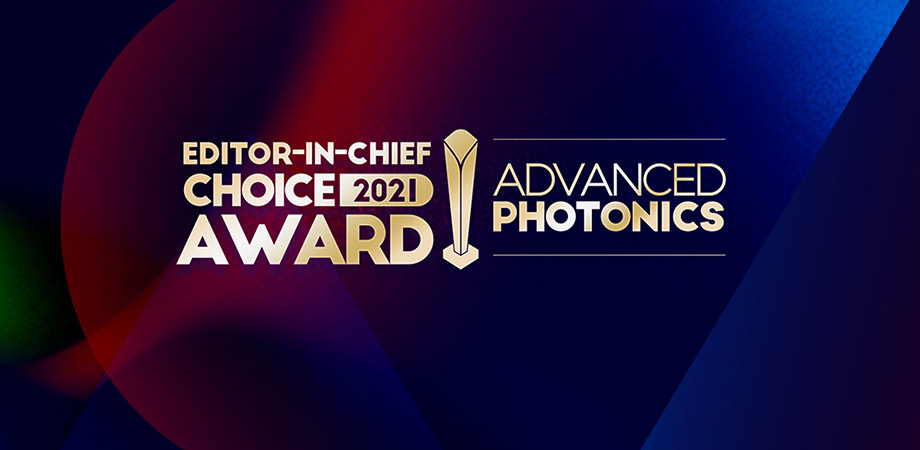SPIE-CLP journal Advanced Photonics announces annual best papers recognition

BELLINGHAM, Washington, USA – Advanced Photonics, an open access journal published by SPIE, the international society for optics and photonics, and Chinese Laser Press, has presented its 2021 Editor-in-Chief Choice Awards for the best papers published in the journal. Advanced Photonics is published online in the SPIE Digital Library. It is a highly selective, open access, international journal publishing innovative research in all areas of optics and photonics, including fundamental and applied research.
The Advanced Photonics Editor-in-Chief Choice Awards, established in 2020, recognize exceptional papers, based on the importance of the work to the optics and photonics field. From Advanced Photonics articles published between December 2020 and December 2021, two winners were selected by the journal's Co-Editor-in-Chief Xiao-Cong (Larry) Yuan, of Shenzhen University, and Co-Editor-in-Chief Anatoly Zayats of King's College London: an original research article and a review article.
The winning research article is “Ultrawideband chromatic aberration-free meta-mirrors” by Tong Cai of Zhejiang University and the Air Force Engineering University, China; Shiwei Tang of Ningbo University, China; Guangming Wang and Wenye Ji of the Air Force Engineering University; and Bin Zheng, Chao Qian, Zuojia Wang, Erping Li, Hongsheng Chen all of Zhejiang University.
In their paper, the authors propose a general strategy to design chromatic aberration-free meta-devices with high-efficiency and ultrabroadband properties by satisfying the key criteria of desirable phase dispersion and high reflection amplitudes at the target frequency interval. As part of their research — and as proof-of-concept — two microwave meta-devices are designed, fabricated, and experimentally characterized.
“Broadband response of metasurfaces is crucial for many applications throughout the electromagnetic spectrum and is difficult to achieve without associated aberrations,” notes Zayats. “In this paper, the authors propose a fascinating approach to overcome this important limitation in the microwave regime. The results provide food for thought and interesting recipes for scientists working in other spectral ranges for designing broadband performance of their metasurfaces.”
The winning review article is "Optical trapping with structured light: a review" by Yuanjie Yang of the University of Electronic Science and Technology of China; Yuxuan Ren of Fudan University, China; Mingzhou Chen of the University of St. Andrews, United Kingdom; Yoshihiko Arita of the University of St. Andrews and Chiba University, Japan; and Carmelo Rosales-Guzmán of the Center for Research in Optics (CIO), Mexico, and Harbin University of Science and Technology, China.
In the review, the authors offer a status update of the field of optical manipulation with structured light. They review the breadth of structured beam research and discuss recent advances in optical manipulation employing structured beams for both scalar and vectorial forms. They also provide an overview of seminal contributions that have changed the landscape of optical tweezers. “This emerging field is being continuously and rapidly reshaped by new approaches,” they write in their introduction, “and we hope this paper will appeal to a broad audience with an interest in optical manipulation techniques.”
“Optical tweezers technology won the 2018 Nobel Prize in Physics and has important applications in physics, biomedicine, and other fields, while structured light is one of the most active frontier subjects of optics,” says Yuan. “In this review, the authors address the remarkable progress that has been made in optical trapping with different structured beams, including optical trapping in air, the optical transporting of metal nanoparticles, and the biomedical application of optical trapping. This review is a valuable contribution to the community regarding optical tweezers as well as optics.”
About SPIE
SPIE, the international society for optics and photonics, brings engineers, scientists, students, and business professionals together to advance light-based science and technology. The Society, founded in 1955, connects and engages with our global constituency through industry-leading conferences and exhibitions; publications of conference proceedings, books, and journals in the SPIE Digital Library; and career-building opportunities. Over the past five years, SPIE has contributed more than $22 million to the international optics community through our advocacy and support, including scholarships, educational resources, travel grants, endowed gifts, and public-policy development. www.spie.org.
Contact:
Daneet Steffens
Public Relations Manager
daneets@spie.org
+1 360 685 5478
@SPIEtweets



